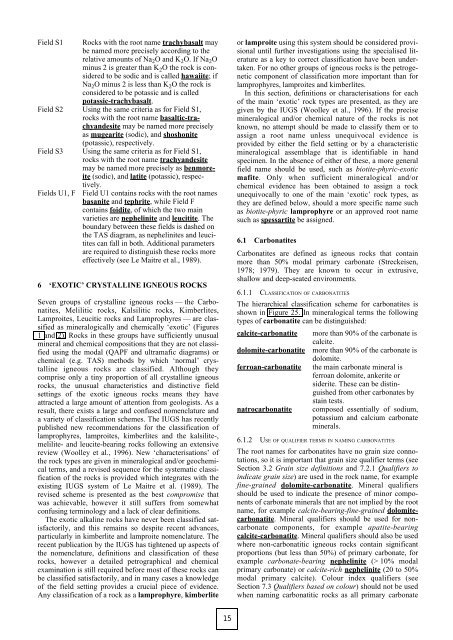Rock Classification Scheme (BGS).pdf - The Water, Sanitation and ...
Rock Classification Scheme (BGS).pdf - The Water, Sanitation and ...
Rock Classification Scheme (BGS).pdf - The Water, Sanitation and ...
Create successful ePaper yourself
Turn your PDF publications into a flip-book with our unique Google optimized e-Paper software.
Field S1 <strong>Rock</strong>s with the root name trachybasalt maybe named more precisely according to therelative amounts of Na 2 O <strong>and</strong> K 2 O. If Na 2 Ominus 2 is greater than K 2 O the rock is consideredto be sodic <strong>and</strong> is called hawaiite; ifNa 2 O minus 2 is less than K 2 O the rock isconsidered to be potassic <strong>and</strong> is calledpotassic-trachybasalt.Field S2 Using the same criteria as for Field S1,rocks with the root name basaltic-trachy<strong>and</strong>esitemay be named more preciselyas mugearite (sodic), <strong>and</strong> shoshonite(potassic), respectively.Field S3 Using the same criteria as for Field S1,rocks with the root name trachy<strong>and</strong>esitemay be named more precisely as benmoreite(sodic), <strong>and</strong> latite (potassic), respectively.Fields U1, F Field U1 contains rocks with the root namesbasanite <strong>and</strong> tephrite, while Field Fcontains foidite, of which the two mainvarieties are nephelinite <strong>and</strong> leucitite. <strong>The</strong>boundary between these fields is dashed onthe TAS diagram, as nephelinites <strong>and</strong> leucititescan fall in both. Additional parametersare required to distinguish these rocks moreeffectively (see Le Maitre et al., 1989).6 ‘EXOTIC’ CRYSTALLINE IGNEOUS ROCKSSeven groups of crystalline igneous rocks — the Carbonatites,Melilitic rocks, Kalsilitic rocks, Kimberlites,Lamproites, Leucitic rocks <strong>and</strong> Lamprophyres — are classifiedas mineralogically <strong>and</strong> chemically ‘exotic’ (Figures1 <strong>and</strong> 2). <strong>Rock</strong>s in these groups have sufficiently unusualmineral <strong>and</strong> chemical compositions that they are not classifiedusing the modal (QAPF <strong>and</strong> ultramafic diagrams) orchemical (e.g. TAS) methods by which ‘normal’ crystallineigneous rocks are classified. Although theycomprise only a tiny proportion of all crystalline igneousrocks, the unusual characteristics <strong>and</strong> distinctive fieldsettings of the exotic igneous rocks means they haveattracted a large amount of attention from geologists. As aresult, there exists a large <strong>and</strong> confused nomenclature <strong>and</strong>a variety of classification schemes. <strong>The</strong> IUGS has recentlypublished new recommendations for the classification oflamprophyres, lamproites, kimberlites <strong>and</strong> the kalsilite-,melilite- <strong>and</strong> leucite-bearing rocks following an extensivereview (Woolley et al., 1996). New ‘characterisations’ ofthe rock types are given in mineralogical <strong>and</strong>/or geochemicalterms, <strong>and</strong> a revised sequence for the systematic classificationof the rocks is provided which integrates with theexisting IUGS system of Le Maitre et al. (1989). <strong>The</strong>revised scheme is presented as the best compromise thatwas achievable, however it still suffers from somewhatconfusing terminology <strong>and</strong> a lack of clear definitions.<strong>The</strong> exotic alkaline rocks have never been classified satisfactorily,<strong>and</strong> this remains so despite recent advances,particularly in kimberlite <strong>and</strong> lamproite nomenclature. <strong>The</strong>recent publication by the IUGS has tightened up aspects ofthe nomenclature, definitions <strong>and</strong> classification of theserocks, however a detailed petrographical <strong>and</strong> chemicalexamination is still required before most of these rocks canbe classified satisfactorily, <strong>and</strong> in many cases a knowledgeof the field setting provides a crucial piece of evidence.Any classification of a rock as a lamprophyre, kimberliteor lamproite using this system should be considered provisionaluntil further investigations using the specialised literatureas a key to correct classification have been undertaken.For no other groups of igneous rocks is the petrogeneticcomponent of classification more important than forlamprophyres, lamproites <strong>and</strong> kimberlites.In this section, definitions or characterisations for eachof the main ‘exotic’ rock types are presented, as they aregiven by the IUGS (Woolley et al., 1996). If the precisemineralogical <strong>and</strong>/or chemical nature of the rocks is notknown, no attempt should be made to classify them or toassign a root name unless unequivocal evidence isprovided by either the field setting or by a characteristicmineralogical assemblage that is identifiable in h<strong>and</strong>specimen. In the absence of either of these, a more generalfield name should be used, such as biotite-phyric-exoticmafite. Only when sufficient mineralogical <strong>and</strong>/orchemical evidence has been obtained to assign a rockunequivocally to one of the main ‘exotic’ rock types, asthey are defined below, should a more specific name suchas biotite-phyric lamprophyre or an approved root namesuch as spessartite be assigned.6.1 CarbonatitesCarbonatites are defined as igneous rocks that containmore than 50% modal primary carbonate (Streckeisen,1978; 1979). <strong>The</strong>y are known to occur in extrusive,shallow <strong>and</strong> deep-seated environments.6.1.1 CLASSIFICATION OF CARBONATITES<strong>The</strong> hierarchical classification scheme for carbonatites isshown in Figure 25. In mineralogical terms the followingtypes of carbonatite can be distinguished:calcite-carbonatite more than 90% of the carbonate iscalcite.dolomite-carbonatite more than 90% of the carbonate isdolomite.ferroan-carbonatite the main carbonate mineral isferroan dolomite, ankerite orsiderite. <strong>The</strong>se can be distinguishedfrom other carbonates bystain tests.natrocarbonatite composed essentially of sodium,potassium <strong>and</strong> calcium carbonateminerals.6.1.2 USE OF QUALIFIER TERMS IN NAMING CARBONATITES<strong>The</strong> root names for carbonatites have no grain size connotations,so it is important that grain size qualifier terms (seeSection 3.2 Grain size definitions <strong>and</strong> 7.2.1 Qualifiers toindicate grain size) are used in the rock name, for examplefine-grained dolomite-carbonatite. Mineral qualifiersshould be used to indicate the presence of minor componentsof carbonate minerals that are not implied by the rootname, for example calcite-bearing-fine-grained dolomitecarbonatite.Mineral qualifiers should be used for noncarbonatecomponents, for example apatite-bearingcalcite-carbonatite. Mineral qualifiers should also be usedwhere non-carbonatitic igneous rocks contain significantproportions (but less than 50%) of primary carbonate, forexample carbonate-bearing nephelinite (> 10% modalprimary carbonate) or calcite-rich nephelinite (20 to 50%modal primary calcite). Colour index qualifiers (seeSection 7.3 Qualifiers based on colour) should not be usedwhen naming carbonatitic rocks as all primary carbonate15
















